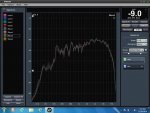Here is the dilemma, I have a pile of line array elements and I know there are some issues, as one side just didn't sound as bright as the other side. I flopped L/R drive cables from amp racks "unchanged". Settings on the boxes were correct. So I numbered the boxes as they came down to investigate.
Opened a few I was sure should have blown out hi drivers, everything tested out ok both sweeping with the generator and Multi Meter.
Here is my next goal, hook up a box after box in the same location and sweep or pink noise it under full power on the bench with an RTA mic remaining in the same location and somehow record the amplitude along the freq. Then take the results with them plotted out and know which boxes have drivers not performing properly...
Ok I have a copy of smaart 7 but I am not sure it is the ideal software for this project. Ideas?
Opened a few I was sure should have blown out hi drivers, everything tested out ok both sweeping with the generator and Multi Meter.
Here is my next goal, hook up a box after box in the same location and sweep or pink noise it under full power on the bench with an RTA mic remaining in the same location and somehow record the amplitude along the freq. Then take the results with them plotted out and know which boxes have drivers not performing properly...
Ok I have a copy of smaart 7 but I am not sure it is the ideal software for this project. Ideas?

